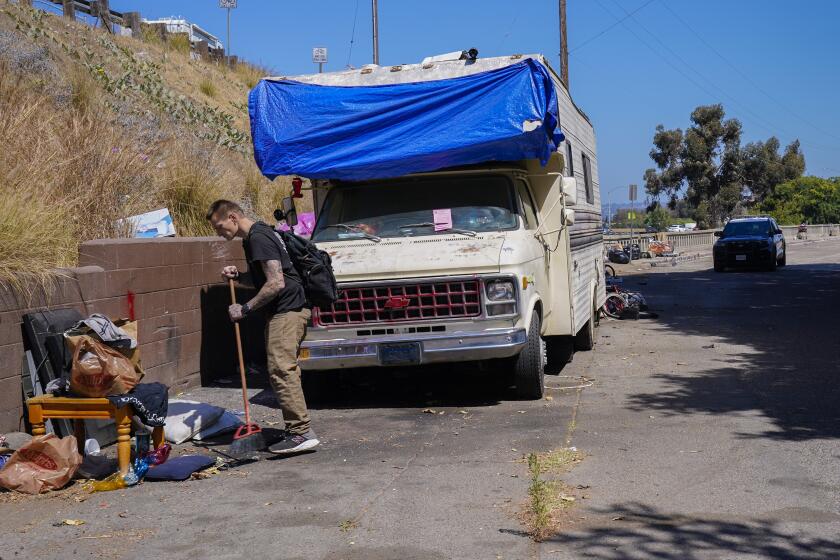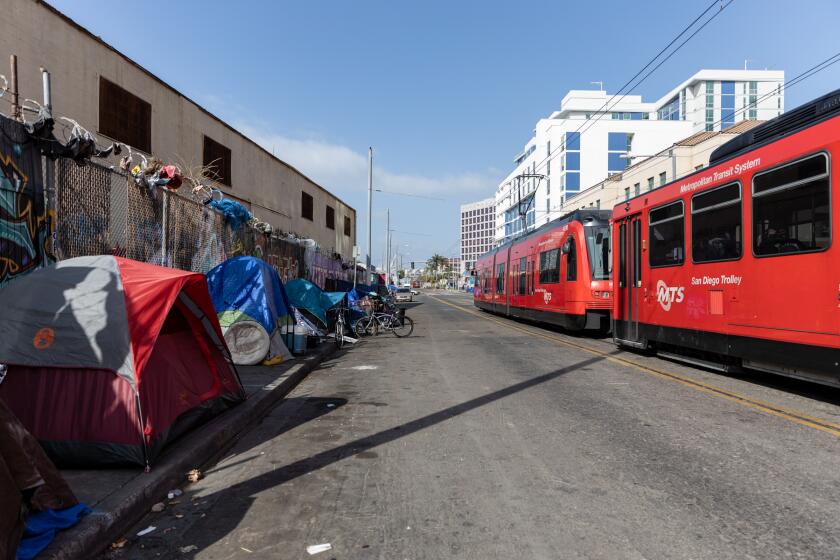Homeless are preparing for El Niño
Theo gladly took some of the snacks he was offered by members of the Alpha Project, but he didn’t need the homeless outreach team’s advice about El Niño.
“A lot of people have moved up,” he said outside his encampment near the San Diego River in Mission Valley. “They’ve moved to places where it’s safe.”
Theo, who didn’t give his last name, is homeless and has spent the last 13 years camping near the riverbed close to Qualcomm Stadium, where several tents are hidden just beyond the parking lot near the trolley station.
Teams from the Alpha Project, a nonprofit that helps the homeless, have been periodically checking on people who live near the riverbed to warn them about El Niño, a condition that can bring strong storms. Forecasters have predicted a particularly brutal El Niño this winter.
The San Diego Police Department’s Homeless Outreach Team also has been making rounds to warn the homeless about possible dangers from flooding. Their efforts included plans to work with lifeguards to help evacuate people from flooded areas and notifying people of possible dangers by distributing flyers.
Theo is well aware of the threat, having lived through a past El Niño that he said caused the river to spill into the parking lot and flood the dugouts used by the Padres before the team moved to Petco Park.
Another man, Millard, also at the encampments by the stadium, said he isn’t too worried about how people near the river will fare during a flood.
“These people, they’ll learn,” said Millard, 57, who wore a Navy cap and recalled enduring 9-degrees below zero temperatures in a pup tent when station in Germany.
Millard himself isn’t worried about possibly flood, as he was about to move into an apartment supplied by the Veterans Administration.
For an unknown number of other people, however, the threat of danger is real.
Many people already grasp the threat and have taken to higher ground, said Brandon Smith of the Alpha Project, who estimates the number of people in the 20-mile stretch of the riverbed has dropped from 250 to 100 since the summer.
The ones who stayed behind may have a false sense of security about their situation because they’ve moved their tents away from the riverbank, he and other team members fear.
Members of the Police Department’s Homeless Outreach Team also are worried that people in the riverbed will wait until the last minute before evacuating, and officers have plans to be stationed above the river during heavy rains to meet people who need emergency assistance.
Some relief for those and other homeless was announced this week when San Diego officials revealed a plan to increase the number of emergency shelter beds from 350 to 600 this winter.
Still, there are concerns that when a storm hits, homeless people who thought they could wait out the rain may be caught by a surprise flood or mudslide.
Chrisy McLellan has been living with Theo and her Chihuahua puppy on what she called an island in the river just south of the stadium, but she doesn’t plan on staying long because of the pending El Niño.
“My mother-in-law’s been telling me all about it lately,” she said. “She said, ‘I want you inside.’ She sends me weather reports all the time. That’s why I’m kind of getting away from here.”
Theo also plans to leave before the weather hits, and is thinking of heading to Mexico.
Smith and three other Alpha Project members cautiously walked the edge of the parking lot, looking into the camp sites just feet away from where football fans tailgate on Sundays. The bottled water, snacks and blankets they carried in snacks help break the ice when they meet new people.
“There’s an El Niño coming,” Alpha Project member Carlos Juarez said to one person he met. “It’s going to rain real bad.”
Everyone they met seemed to know about predicted storms, but the team can never tell how many people they missed. Searching for people in canyons and the river bank can be hit and miss, and even dangerous.
“They set traps,” Juarez said about some people who live in canyons and sometimes rig bamboo shafts to spring up and smack people on the face if stepped on.
On the advice of police, the team doesn’t venture into the Hillcrest-area canyon known as Camelot, where up to 100 people are estimated to live.
Walking into the camps just behind the stadium, it’s clear there are more people hidden than seen. Whistles echo through the riverbed as a warning of intruders as the team enters the brush, and a hand-written message on a cardboard sign warns, “No visitors anymore. THIS MEANS YOU.”
Some camps are littered with empty bottles, shopping carts, bicycles and clothes. Another is neatly raked, with trash cans and even a lawn ornament. One has a large smoker and other barbecues. Another has a long PVC pipe strung between trees, possibly to drape fabric for privacy.
“There was violence here,” said Alpha Project’s Smith as he walked into one thrashed camp where clothes had been scattered in all directions. “We see that a lot.”
Leaving the stadium parking lot, the team drives the Alpha Project van to Old Town, then parks on Pacific Highway to take the trail that parallels the river.
They found remnants of campsites, but no people other than one homeless man wearing a Purple Heart cap who said he likes to sit on his walker and bird watch. He usually leaves at nightfall, he said, just as people begin arriving with tents.
As the Alpha Project members walked along a paved trail paralleling the riverbed, they met a park ranger driving past in a pickup filled with broken portable chairs, torn tents and other remnants of campsites in the area.
The ranger said he and members of the police Homeless Outreach Team had been in the riverbed area that morning to remove the items, which explained the relatively clean look of the waterway.
Still, the Alpha Project team found other clear signs of camp sites, including a full mattress under an overpass and clothes and other items near the bridge columns.
Travis Easter, media relations coordinator for the San Diego Police Department, said the Homeless Outreach Team is taking several steps to prepare for El Niño.
Team members have coordinated with the Regional Task Force on the Homeless and used thermal image technology to help locate people. They plan to leave warning fliers in empty camps with phone numbers of team members and a list of places to go for help.
They also are working with patrol divisions to make contact with as many people as possible in potential flood areas to warn them about El Niño, Easter said.
Homeless Outreach Team officers also will be stationed around access points near the river during heavy rains, and they will coordinate with San Diego lifeguards, who have offered to transport them by boat to people who can’t be reached by land, he said.
Get Essential San Diego, weekday mornings
Get top headlines from the Union-Tribune in your inbox weekday mornings, including top news, local, sports, business, entertainment and opinion.
You may occasionally receive promotional content from the San Diego Union-Tribune.












